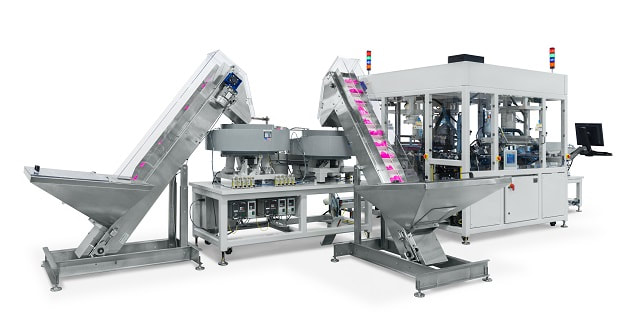Automated assembly stations provide higher productivity and product quality while lowering product cost in a fraction of the space required for conventional tooling.
Staying competitive in the drive toward smart manufacturing often means fully automating assembly, packaging and inspection operations. Many manufacturers are finding that high speed, high precision assembly stations optimize production workflows while improving product quality.
Compact modular assembly stations can provide the performance and precision needed to modernize or ramp up a manufacturing production line. A new assembly station will occupy a fraction of the space used by existing tooling. DWFritz has found that manufacturers can target throughput from 50 parts per minute to 10 parts per second (a 10X increase), with reject rates below 0.5%.
Manufacturers can increase production capacity within an existing facility by leveraging higher per-station throughput, higher yields and installation of multiple new stations in the space of a single old one. For example, as part of its efforts to implement a smart factory for producing air conditioners, a leading electronics company used a fully automated production system, 3D scanners, Internet of Things (IoT) technologies and integrated machine control, according to Deloitte Insights. The company saw a 25% improvement in productivity and 50% fewer defective products.
When considering the benefits offered by automation, some manufacturers may start small with manageable components and then scale quickly to grow smart factory operations.
Building a Custom Automation Assembly Station
A high productivity assembly station must be able to feed in all product components, assemble them and package them, performing critical inspections along the way — all without manual assistance. From input and assembly to inspection and operator safety, this sets up a challenging set of the following system requirements.

This modular assembly and inspection station uses an innovative material handling system.
Flexible input and output: Input components may be delivered using any of several form factors, including stacks of trays, reels, cassettes, sorters, bowls and hoppers. Components may need to be sorted and aligned before use. Reel products must be accurately sized and placed. Multiple outputs must be provided for finished product in one or more bins, test and inspection failures, and rework candidates as well as empty component carriers.
Precision assembly: Precision robots must perform assembly and packaging steps while running at high speeds and maintaining high uptimes. Movement accuracy and repeatability should be dialed in through control software code changes rather than by reworking the tool. The robots must accommodate misaligned and shifted components, and have robust-to-input variability.
Bonding and laser marking: Assembly may rely on a variety of bonding techniques, including pressure-sensitive adhesives (PSA), precise temperature and ultrasonic welding. Laser marking should imprint any image that includes binning information and serial numbers.
Material handling: Components and product must move through the process using precision conveyors, rotating tables and pick-and-place machines, arranged to optimize the footprint. Pick-and-place robots should be capable of positioning components with micron accuracy.
High speed inspection: Automated metrology and inspection ensure high quality finished goods. Are the product dimensions correct? Are gaps, voids and spacing within tolerances? Are there any cosmetic issues, faulty welds or compromised package seals?
Software control: Software control and hardware modularity will ensure greater reuse, extending the lifetime of the station. Changes in specifications, throughput and internal process timing can all be adjusted in software control with minimal changes to the station. Sophisticated interactions between sensors and actuators mean precise, repeatable operations and a wider process window.
Hardware modularity: Elements that are shaped or sized for specific components can be built separately and integrated as modules. If the shape or size of a component changes, only its module has to change while the rest of the station can remain in service.
Operator safety: Automated stations must be safe for operators and for technicians making maintenance or alterations. Sensors and other protective elements will keep hands and hair away from moving parts, shutting down the machine if necessary.
Investment in the Smart Factory
Between software-driven subsystems and hardware modularity, the initial tooling investment is protected for far longer than is possible using conventional tooling. And ongoing process changes can be implemented quickly, with minimal downtime, keeping the line adaptable and nimble.
With automated assembly systems, manufacturers can simultaneously boost productivity, reliability and product quality while reducing production costs.
